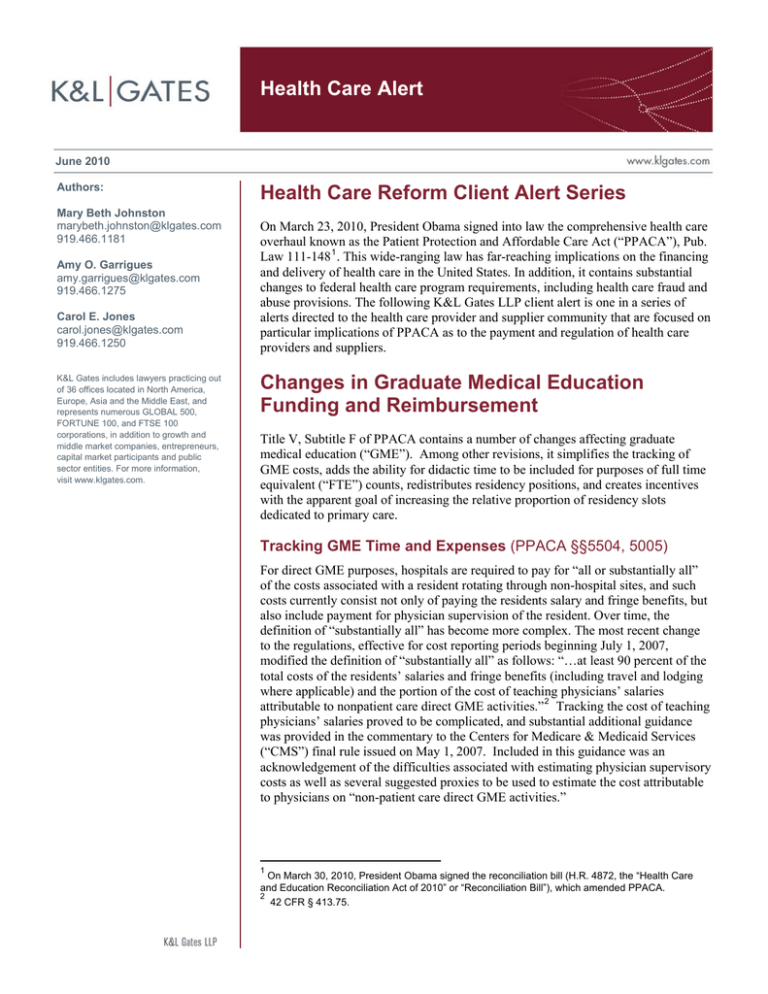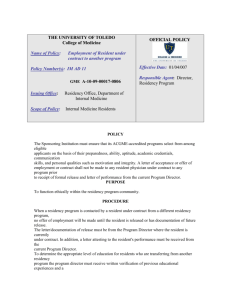
Health Care Alert
June 2010
Authors:
Mary Beth Johnston
marybeth.johnston@klgates.com
919.466.1181
Amy O. Garrigues
amy.garrigues@klgates.com
919.466.1275
Carol E. Jones
carol.jones@klgates.com
919.466.1250
K&L Gates includes lawyers practicing out
of 36 offices located in North America,
Europe, Asia and the Middle East, and
represents numerous GLOBAL 500,
FORTUNE 100, and FTSE 100
corporations, in addition to growth and
middle market companies, entrepreneurs,
capital market participants and public
sector entities. For more information,
visit www.klgates.com.
Health Care Reform Client Alert Series
On March 23, 2010, President Obama signed into law the comprehensive health care
overhaul known as the Patient Protection and Affordable Care Act (“PPACA”), Pub.
Law 111-148 1 . This wide-ranging law has far-reaching implications on the financing
and delivery of health care in the United States. In addition, it contains substantial
changes to federal health care program requirements, including health care fraud and
abuse provisions. The following K&L Gates LLP client alert is one in a series of
alerts directed to the health care provider and supplier community that are focused on
particular implications of PPACA as to the payment and regulation of health care
providers and suppliers.
Changes in Graduate Medical Education
Funding and Reimbursement
Title V, Subtitle F of PPACA contains a number of changes affecting graduate
medical education (“GME”). Among other revisions, it simplifies the tracking of
GME costs, adds the ability for didactic time to be included for purposes of full time
equivalent (“FTE”) counts, redistributes residency positions, and creates incentives
with the apparent goal of increasing the relative proportion of residency slots
dedicated to primary care.
Tracking GME Time and Expenses (PPACA §§5504, 5005)
For direct GME purposes, hospitals are required to pay for “all or substantially all”
of the costs associated with a resident rotating through non-hospital sites, and such
costs currently consist not only of paying the residents salary and fringe benefits, but
also include payment for physician supervision of the resident. Over time, the
definition of “substantially all” has become more complex. The most recent change
to the regulations, effective for cost reporting periods beginning July 1, 2007,
modified the definition of “substantially all” as follows: “…at least 90 percent of the
total costs of the residents’ salaries and fringe benefits (including travel and lodging
where applicable) and the portion of the cost of teaching physicians’ salaries
attributable to nonpatient care direct GME activities.” 2 Tracking the cost of teaching
physicians’ salaries proved to be complicated, and substantial additional guidance
was provided in the commentary to the Centers for Medicare & Medicaid Services
(“CMS”) final rule issued on May 1, 2007. Included in this guidance was an
acknowledgement of the difficulties associated with estimating physician supervisory
costs as well as several suggested proxies to be used to estimate the cost attributable
to physicians on “non-patient care direct GME activities.”
1
On March 30, 2010, President Obama signed the reconciliation bill (H.R. 4872, the “Health Care
and Education Reconciliation Act of 2010” or “Reconciliation Bill”), which amended PPACA.
2
42 CFR § 413.75.
Health Care Alert
PPACA appears to be reversing this relatively recent
change by eliminating the requirement to pay for
physician supervision in non-hospital settings as of
July 1, 2011. Hospitals must only pay “the costs of
the stipends and fringe benefits of the resident
during the time” that the intern or resident rotates
through nonprovider settings.
Additionally, PPACA expands what may be
included in the FTE count during rotations in
nonprovider settings (as of July 1, 2009) and for
indirect medical education purposes (as of October
1, 2001). Specifically, PPACA allows for the time
spent by residents in didactic seminars and
conferences to be included. 3 PPACA also allows
time spent by the intern or resident on vacation, sick
leave, or other approved leave to be included in the
determination of FTE count, provided, however, that
such leave does not prolong the total time the
resident participates in the approved program
beyond the normal duration of the program.
Redistribution of Residency Positions
(PPACA § 5503)
Under PPACA, residency positions will be
redistributed among hospitals in a manner that is
likely to result in an increased number of primary
care and/or general surgery positions. The manner
in which the redistributions are to take place is as
follows:
3
Reduction in Resident FTE Caps: Effective
July 1, 2011, the FTE cap will be reduced for
hospitals whose FTE resident count, in each of
the last three cost reporting periods, was lower
than its FTE cap. The reduction will be equal to
65 percent of the difference between the FTE
cap and the FTE resident count. Certain
hospitals, including rural hospitals with fewer
than 250 acute care beds, will be excluded from
the reduction.
Redistribution of Resident FTE Positions:
Hospitals must apply to receive additional
Note, however, that research not associated with the
treatment or diagnosis of a particular patient continues to not
be included in the calculation.
residency positions. Priority in determining
which hospitals receive the redistributed slots
will be given to hospitals located in states with
a resident-to-population ratio in the lowest
quartile, in rural areas or in states with a
relatively high proportion of designated health
professional shortage areas. Applicants must be
able to show an ability to fill such additional
positions within three years, and preference will
be shown to those with an accredited rural
training track. Ultimately, the total number of
additional resident positions granted to
qualifying hospitals will remain capped by the
total decrease in resident positions recouped
from hospitals with unused resident positions,
and a particular hospital may not receive more
than 75 new FTE positions.
Maintaining New Resident FTE Slots: For
five years, hospitals receiving any of the
additional positions must maintain their
baseline average number of FTE primary care
residents, calculated based on the number of
residents in the three cost reporting periods
prior to PPACA enactment, and at least 75
percent of the redistributed positions must be
reassigned to either primary care or general
surgery residency slots. If the hospital does not
meet these conditions, the hospital’s resident
limit will be reduced by the same amount as it
was increased and the resident positions will be
redistributed to other hospitals that meet the
PPACA criteria.
GME in Teaching Health Centers
(PPACA § 5508)
PPACA also provides for an increase in primary
care resident training capacity by creating a grant
program for teaching health centers for establishing
new or expanded primary care residency programs.
Primary care residency program is broadly defined
as “an approved graduate medical residency training
program in family medicine, internal medicine,
pediatrics, internal medicine-pediatrics, obstetrics
and gynecology, psychiatry, general dentistry,
pediatric dentistry, and geriatrics.” A teaching
health center is a community-based, ambulatory
patient care center that operates a primary care
June 2010
2
Health Care Alert
residency program, including, but not limited to,
federally qualified health centers, community mental
health centers, and rural health clinics.
The grants total $125 million over the next three
years with a $500,000 per award limit and are
intended to cover costs for primary care curriculum
development, recruitment, training, accreditation by
the Accreditation Council for Graduate Medical
Education (ACGME) and faculty salaries during the
development phase. Preference will be given to
those applicants that have existing affiliation
agreements with area health education center
programs.
Conclusion
In light of these changes, providers should consider
revisiting their procedures for tracking direct GME
costs as well as reviewing the distribution of
residency slots among the specialties in their
residency programs.
Direct GME Cost Tracking – Academic medical
centers should review their current contractual
arrangements as well as process for tracking direct
graduate medical expenses and, where appropriate:
Simplify (or develop) contracts between the
provider and nonhospital locations for the
reimbursement of the cost of resident training
which are consistent with the new definition of
resident costs;
Establish the appropriate level of documentation
associated with capturing resident cost
information under the new guidelines; and
Review cost of human resources invested in
tracking resident costs.
Even though the requirements for tracking resident
costs will be simplified for direct GME purposes
providers must also consider applicable Fraud and
Abuse regulations and associated Fair Market Value
requirements in considering how to handle
payments for physician supervision.
Primary Care Residency Position Planning –
Hospitals with approved medical residency training
programs should review the distribution of positions
by specialty and analyze how the redistribution of
residency slots stipulated by PPACA may affect
their GME programs.
Boston
Paul W. Shaw
paul.shaw@klgates.com
617.261.3111
Harrisburg
Ruth E. Granfors
ruth.granfors@klgates.com
717.231.5835
Miami
William J. Spratt
william.spratt@klgates.com
305.539.3320
Newark
Stephen A. Timoni
stephen.timoni@klgates.com
973.848.4020
Pittsburgh
Edward V. Weisgerber
ed.weisgerber@klgates.com
412.355.8980
Stephanie D. Wall
stephanie.wall@klgates.com
412.355.8364
Research Triangle Park
Mary Beth Johnston
marybeth.johnston@klgates.com
919.466.1181
Amy O. Garrigues
amy.garrigues@klgates.com
919.466.1275
Carol E. Jones
carol.jones@klgates.com
919.466.1250
Anchorage Austin Beijing Berlin Boston Charlotte Chicago Dallas Dubai Fort Worth Frankfurt Harrisburg Hong Kong London
Los Angeles Miami Moscow Newark New York Orange County Palo Alto Paris Pittsburgh Portland Raleigh Research Triangle Park
San Diego San Francisco Seattle Shanghai Singapore Spokane/Coeur d’Alene Taipei Tokyo Warsaw
Washington, D.C.
June 2010
3
Health Care Alert
K&L Gates includes lawyers practicing out of 36 offices located in North America, Europe, Asia and the Middle East, and represents numerous
GLOBAL 500, FORTUNE 100, and FTSE 100 corporations, in addition to growth and middle market companies, entrepreneurs, capital market
participants and public sector entities. For more information, visit www.klgates.com.
K&L Gates is comprised of multiple affiliated entities: a limited liability partnership with the full name K&L Gates LLP qualified in Delaware and
maintaining offices throughout the United States, in Berlin and Frankfurt, Germany, in Beijing (K&L Gates LLP Beijing Representative Office), in
Dubai, U.A.E., in Shanghai (K&L Gates LLP Shanghai Representative Office), in Tokyo, and in Singapore; a limited liability partnership (also named
K&L Gates LLP) incorporated in England and maintaining offices in London and Paris; a Taiwan general partnership (K&L Gates) maintaining an
office in Taipei; a Hong Kong general partnership (K&L Gates, Solicitors) maintaining an office in Hong Kong; a Polish limited partnership (K&L
Gates Jamka sp. k.) maintaining an office in Warsaw; and a Delaware limited liability company (K&L Gates Holdings, LLC) maintaining an office in
Moscow. K&L Gates maintains appropriate registrations in the jurisdictions in which its offices are located. A list of the partners or members in each
entity is available for inspection at any K&L Gates office.
This publication is for informational purposes and does not contain or convey legal advice. The information herein should not be used or relied upon
in regard to any particular facts or circumstances without first consulting a lawyer.
©2010 K&L Gates LLP. All Rights Reserved.
June 2010
4





